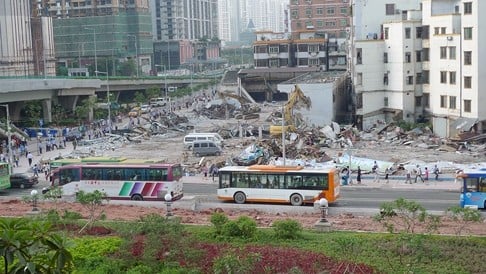
Book review: the human cost of China’s rush to urbanisation
Dragons in Diamond Village describes how the authorities collude with land developers and thugs to dispossess some of the country’s poorest and most vulnerable


by David Bandurski
Penguin Random House

China’s population is urbanising faster than any other nation in history, and that’s nearly always presented as a sign of progress and development. It’s not quite so simple, as David Bandurski shows in his well researched and solidly written book, Dragons in Diamond Village, examining the truth behind China’s massive, chaotic and historically important push to urbanise.
Guangzhou’s drive to become a “National Model City” ahead of the 2010 Asia Games sparked a massive redevelopment drive and battle over the land of the 138 urban villages in the rapidly growing city. But this book also tells a much broader story about China’s disregard for personal rights and freedoms, and the treacherous collaboration between developers, the government and ordinary thugs.
Bandurski, the editor of the China Media Project at the University of Hong Kong, spent nearly 10 years reporting and researching this story, and the solid journalism shines through on every page. He offers colourful anecdotes and portraits of a slice of Chinese urban life that few foreigners ever get to see, and that the Chinese media rarely investigate.
The title refers to dragon boating, at the heart of village traditions and unity, and the land the villages are built on, which many consider to be worth as much as diamonds due to their proximity to urban centres. The narrative centres on Xian Village, in the middle of Guangzhou’s central business district.

Land is at the heart of much of Chinese economics and politics, both at the local level and nationally. The cities rely on land to generate growth and revenue, and the easiest way to do that is to seize land from neighbouring villages and sell it to property developers at huge profits. Bandurski shows how the government not only allows this criminal activity, but facilitates and profits from it.
The new properties that are built are usually unaffordable to the villagers who previously lived on the land. In fact, many of the flats are never sold, instead swapped by speculating investors and left empty, creating the gleaming new but empty neighbourhoods one sees driving through many Chinese cities.
Bandurski shows how this economic and political force plays out in various lives: Huang Minpeng, a semi-literate farmer who becomes a rights defender and a thorn in the side of corruption; He Jieling, a suburban housewife who uses her life savings to open a hair salon; and Lu Suigeng, the head of the Xian Village and the man who facilitates the theft of the land.
Bandurski has tracked money and power through a labyrinth of holding companies, government departments and secretive alliances – an admirable feat
“Like those of so many other bilked investors, He Jieling’s dreams had been destroyed at Ha Street. They had been hollowed out by a society in which the law was corrupted by power, and as a result her personal rights were nothing more than a fantasy.”
Bandurski also explores the role that China’s hukou system of household registration has played in this property war. Migrant workers flocking to China’s cities often do not have the correct permits to allow them to live in the urban centres, so instead they find housing in the urban villages, making the razing of these villages even more detrimental to China’s poorer, rural class.
The writer does an excellent job of lifting the veil on the chengguan and showing the terrorising effect they have, describing them as “mercenary armies of quasi-police scrambled by local city governments across China to handle the dirty business of urban order and cleanliness and to tackle sensitive and, often, dangerous jobs”.
Bandurski has tracked money and power through a labyrinth of holding companies, government departments and secretive alliances – an admirable feat. However, his narrative is often overwhelmed by the cascade of facts and information his research has uncovered. While he interprets the information for the reader, its blunt delivery often jars us from an otherwise powerful and emotional story.
Still, this is an ambitious and thorough piece of journalistic non-fiction that combines powerful storytelling with a righteous mission. Bandurski has a deep knowledge of Chinese history as well as an understanding of how modern China works, creating a very readable book for those who have experience in China as well as those who may be new to the topic.